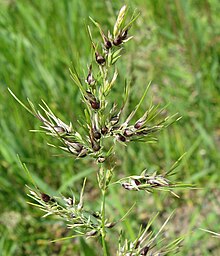Apomixis

Apomixis is reproduction where only one parent passes genes to the offspring.[1] Apomictically produced offspring are genetically identical to the parent (clones).
The method is most seen in plants, especially flowering plants.[2] Brambles (blackberry) are apomictic. Some authorities give "reproduction by special tissues without fertilisation",[3] or "asexual formation of a seed from the maternal tissues of the ovule, avoiding meiosis and fertilization, leading to embryo development".[4]
Apomixis includes some methods which are more common in animals, such as parthenogenesis.
In botany, apomixis was defined by Hans Winkler as the replacement of the normal sexual reproduction by asexual reproduction, without fertilization.[5][6]
Horticulture methods, such as propagation from cuttings or leaves, is not apomixis. Natural replacement of the seed by an asexual method is apomixis.
References[change | change source]
- ↑ King R.C. Stansfield W.D. & Mulligan P.K. 2006. A dictionary of genetics. 7th ed, Oxford University Press, p31. ISBN 0-19-530761-5
- ↑ Gustafsson A. 1945. Apomixis in the higher plants. I. The mechanism of apomixis. Lunds Univ. Arsskr. N.F. Avd. 2, 42 (3): 1-66. Apomixis in higher plants II. The causal aspect of Apomixis. Lunds Univ. Arsskr N.F. Avd. 2, 43 (2): 71-178. Apomixis in higher plants III. Biotype and species formation. Lunds Univ. Arsskr. N.F. Avd. 2, 44 (2) 183-370. A full discussion of Gustafsson's papers is given in Stebbins, G. Ledyard, Jr. 1950. Variation and evolution in plants, p382 et seq.
- ↑ Encyclopedia Britannica
- ↑ Bicknell R.A. & Koltunow A.M. 2004. Understanding apomixis: recent advances and remaining conundrums. The Plant Cell, 16, suppl 1, S228-S245. [1]
- ↑ Winkler, H. (1908). "Über Parthenogenesis und Apogamie im Pflanzenreich". Progressus Rei Botanicae. 2 (3): 293–454.
- ↑ Ross A. Bicknell & Anna M. Koltunow 2004. Understanding apomixis: recent advances and remaining conundrums. The Plant Cell 16 (suppl 1): S228–S245. doi:10.1105/tpc.017921. PMC 2643386. PMID 15131250
